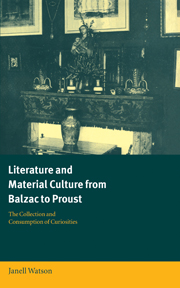Book contents
- Frontmatter
- Contents
- Acknowledgments
- Introduction
- Chapter 1 The bibelot
- Chapter 2 The logic(s) of material culture
- Chapter 3 The fashionable artistic interior
- Chapter 4 Flaubert's “musées reçus”
- Chapter 5 Narrate, describe, or catalogue?
- Chapter 6 The parlour of critical theory
- Chapter 7 Rearranging the Oedipus
- Notes
- Bibliography
- Index
- CAMBRIDGE STUDIES IN FRENCH
Chapter 1 - The bibelot
A nineteenth-century object
Published online by Cambridge University Press: 22 September 2009
- Frontmatter
- Contents
- Acknowledgments
- Introduction
- Chapter 1 The bibelot
- Chapter 2 The logic(s) of material culture
- Chapter 3 The fashionable artistic interior
- Chapter 4 Flaubert's “musées reçus”
- Chapter 5 Narrate, describe, or catalogue?
- Chapter 6 The parlour of critical theory
- Chapter 7 Rearranging the Oedipus
- Notes
- Bibliography
- Index
- CAMBRIDGE STUDIES IN FRENCH
Summary
By the 1880s, the medieval French word bibelot (knick-knack), which in the fifteenth century designated miscellaneous household items of little value, is revived by the most elite among Parisian collectors to designate the objects most precious to them, even though the term is also used to refer to the cheapest industrial kitsch. The term is not only revived and reinvented during the nineteenth century, it is also associated with the century. In Proust this association manifests itself as a break with the twentieth century since, in implicit contrast to the narrator's modernist sensibility, it is only among those characters who reach adulthood before the 1880s that one finds bibeloteurs: Swann, Odette, Charlus, and Madame Verdurin. The term's uses, connotations, and associations, as well as the goods that it designates, evolve along with “the nineteenth century,” as conceptualized by those writers who speak in its name. If this culture embraces the bibelot with enthusiasm, it is because it creates the bibelot in its own image.
The objects designated by the term bibelot, along with the practices designated by its variants, bibeloter [to collect], bibeloteur, and bibeloteuse [masculine and feminine forms for both the noun “collector” and the adjective “bibelot-like”], are invested with a variety of often contradictory significations – not only “meanings” but also “significance” in the sense of perceived importance or value (aesthetic, monetary, sentimental, psychic, or other).
- Type
- Chapter
- Information
- Literature and Material Culture from Balzac to ProustThe Collection and Consumption of Curiosities, pp. 5 - 26Publisher: Cambridge University PressPrint publication year: 2000

